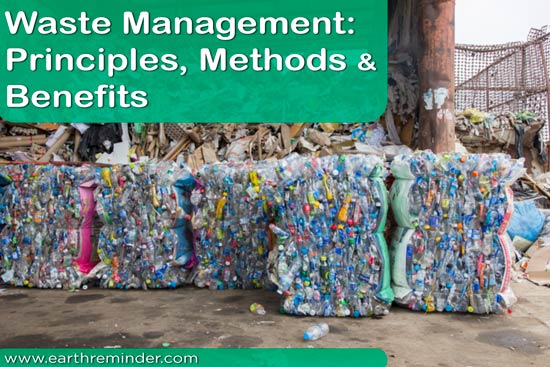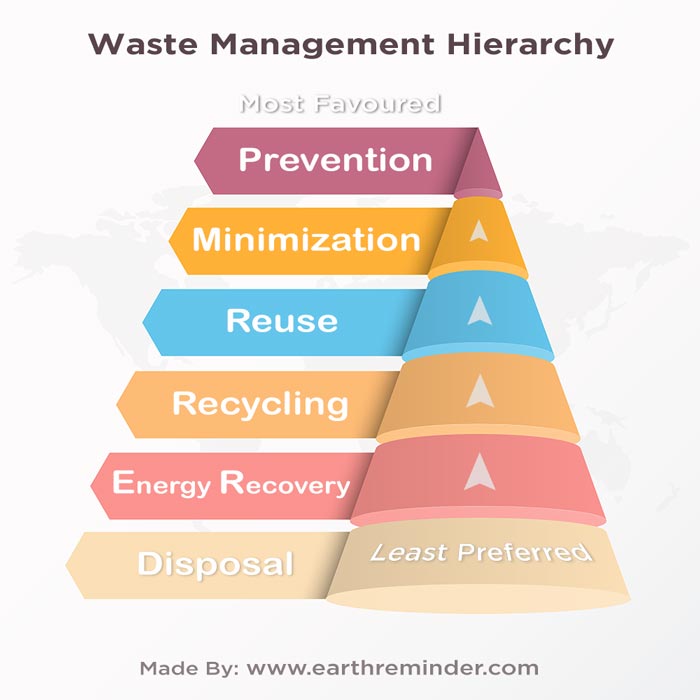Waste Management: Principles, Methods and Benefits
Introduction to Waste Management
Waste management (or waste disposal) refers to all the processes, strategies, and practices that involve managing waste from its production at the state level to its disposal at the national level.
Waste can be categorized into solid, liquid, or gas and each component requires a different type of dumping and treatment. If not managed and treated correctly, they can pose a threat to human beings. Waste management aims at improving the quality of life we live and the environment on which we depend.
Proper waste management is essential for building pollution-free and livable cities, but many developing countries face problems implementing such techniques.
Table of Contents
Principles of Waste Management
Waste management principles include following:
Waste Hierarchy
The first and vital principle of waste management refers to the 3 R’s, Reuse, Recycle, Reduce. The waste hierarchy is represented in the form of a pyramid because the basic premise is the promotion of integrated methods to prevent waste generation.
The upcoming step is to think of various ways by which the waste can be reused again; This step is then followed by the waste recycling step, which includes composting.
The next step includes material restoration, waste conversion, and energy production techniques.
The final and the last step is the disposal of the remaining wastes that can’t be processed further. It includes incineration or disposing of the landfills.
This principle is the cornerstone of most waste minimization strategies.
Circulation of A Product
Design(configuration, layout, pattern, and sketch), mass production, distribution(delivery, supplying, handling, and translocating), and primary use are crucial stages of a product’s life cycle.
All these steps are then followed by the waste hierarchy stages of 3 Rs. Every stage of the life cycle offers several possibilities to rethink, reinvent, and redesign the waste to extend its use and to best suit the people who will use it. This principle focuses on reducing the generation of waste by avoiding the use of limited resources.
Resource Efficiency
Resource efficiency involves the ethical use of our Earth’s limited resources as the rate of restoration of such resources is significantly less than the rate at which we consume them. This principle helps the environment replenish its natural beauty.
Polluter-Pays Principle
This principle states that the polluter or person will pay for the waste he has generated. The polluting party has to pay for the appropriate disposal of the trash after its proper treatment.
Various Methods of Waste Management
Landfills
Throwing daily wastes in landfills is the most common method used for waste disposal. Landfills are mainly found in developing countries. But every process has its drawbacks.
Trash buried in the landfills may leak some harmful chemicals that can pollute natural resources such as rivers or soil and can be fatal to humans and animals.
Incineration
Incineration is another method in which waste from municipalities, hospitals, and other types of e-waste is burnt at very high temperatures.
One major merit of this process, over other processes, is that it reduces the volume of trash by about 80% of its initial volume. This process is popular in the U.S. and Japan, where landfill sites are no longer available.
Recovery and Recycling
Resource recovery is the process by which materials are recovered after being adequately treated. Recycling is a stage at which different components of trash are recycled to produce new products, which not only helps in saving energy but also lowers our greed of consuming fresh raw materials for various purposes.
This process helps keep our environment neat and clean, reduces land and water pollution, reduces our dependence on natural resources, and reduces the El Nino effect that contributes to global warming.
Composting
Composting is a naturally occurring bio-degradable process. In this process, all the organic wastes(plant and kitchen wastes)are taken and left to decompose over time to obtain highly nutritious plant foods.
Compost also acts as manure that enhances soil fertility; This is one of the best methods of waste disposal, but it has its downsides, too, as it is a slow process compared to other techniques.
Waste-To-Energy
This process involves the conversion of non-recyclable waste items into useable ones through several processes. This energy produces renewable and includes electrical energy and heat energy. In this way, non-recyclable waste can be used over and over again.
Benefits and Advantages of Waste Management
Better Environment
One of the major advantages of a waste management system is that it leads to a better and fresher environment. The methods discussed above ensure that harmful and toxic chemicals such as carbon monoxide, carbon dioxide, and methane get separated from wastes and don’t enter the atmosphere; This will help cut down many factors that adversely impact our environment and make it disease-free.
Increases Employment Opportunities
Various recycling industries and organizations create a lot of job and employment opportunities for sacked people. As more and more organizations and companies adopt this eco-friendly practice, more and more people will join these companies for work, thus creating and selling many recycled products.
Preserves Energy
The process of recycling is of vital importance as it helps generate useful products from garbage. The recycled products can serve as a new energy source that can be used thereafter, thus, reducing our dependency on direct sources of energy.
Waste Management Around the Globe
Here is a list of some innovative, fascinating, and eco-friendly waste management techniques being adopted by different countries all over the globe.
Mexico City, Mexico
Mexico City once had one of the largest landfilling sites, namely, Bordo Poniente dump, located on the outskirts of Mexico City. This landfill contains about 70 million tons of trash. Due to excessive dumping, it was closed in 2011, and the city ran out of the only landfill they had.
In the upcoming years, the city implemented and adopted different strategies and comprehensive collection programs for the recycling of organic wastes to tackle the problem caused after the landfill shut down.
Since being closed down, the landfill has been used as a background for building a biogas power plant that can use the existing 70 million tons of garbage for the generation of electricity. Experts believe that this efficient biogas utilization can help the city reduce greenhouse gas emissions by 1.4 to 2 million tons.
Washington, D.C.
In 2014, Washington, D.C. passed a bill emphasizing the ban of styrofoam containers for food establishments and made compulsorily necessary the use of recyclable or disposable and reusable containers.
In 2019, Mary Cheh, the three ward Council Member introduced the “Zero Waste Omnibus Amendment Act of 2019” to keep Washington, D.C. is following the path to achieving its aim of “zero waste” by 2032. As per Cheh, the new bill totally relies on the 4 R’s, Reduce, Reuse, Recycle, and Recover, to tackle all parts of the waste system.
INDIA
With a vast population, India produces around 62 million metric tons of waste each year, out of which 19 million metric tons of garbage are being littered on streets or waterways. Seeing the current situation, the ministry of the environment launched “SWACHH BHARAT ABHIYAN” in April that criminalizes the open burning of waste and modified the landfill management system.
Moreover, engineers are adopting a strategy in which plastic garbage such as lids, chip bags, bottles, plastic bags is collected and shredded and then added as a substitute for bitumen in road construction. This method of using a waste product to reinvent a useful substitute is cost-effective and nature-friendly.
Edinburgh, Scotland
Edinburgh, Scotland, has adopted a zero-waste generation strategy of waste management in which about 5% of the total trash of landfills will be segregated and recycled. To achieve this, Edinburgh came out with two new facilities, namely an anaerobic digestion plant to generate energy from the farm and other household wastes and a union of both heat and power plants to retrieve energy from leftover wastes.
Waste Generation by Different Regions
| REGIONS | PERCENTAGE (%) (Approx.) |
| Africa (the Middle East and Northern) | 6.39 |
| Africa (Sub Saharian) | 8.62 |
| Latin America and the Caribbean | 11.45 |
| North America | 14.32 |
| South Asia | 16.55 |
| Europe and Central Asia | 19.43 |
| East Asia and Pacific | 23.20 |
( Table Graph – Source: openknowledge.worldbank.org)
CONCLUSION
If we practice proper waste management, we will be able to conserve our planet’s natural beauty and keep on cherishing it for a long time. Inadequate sanitation will lead to significant problems in the future.
Environmental waste management is crucial in maintaining the sanitation of our surrounding environment and keeping the good health of all humans; This requires planning ethically and meticulously as the future of our planet is at stake. If appropriately and logically implemented now, the effectiveness of this process will benefit us and our next generations.

